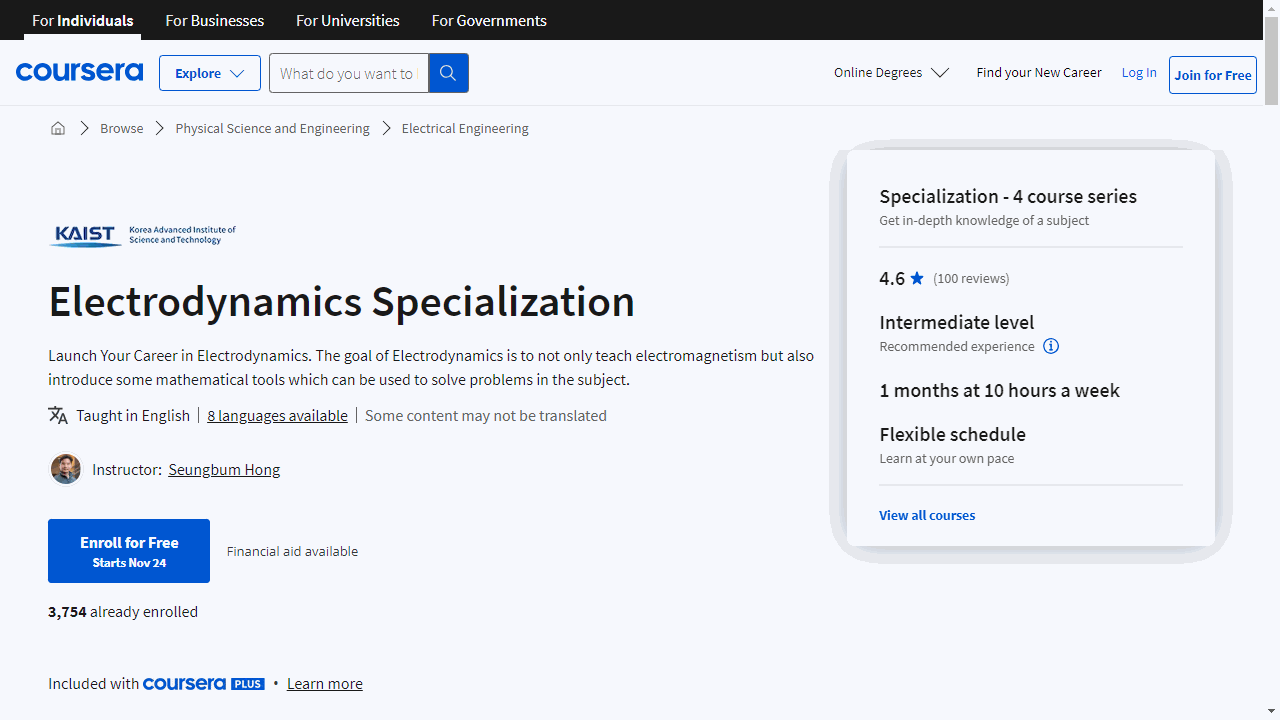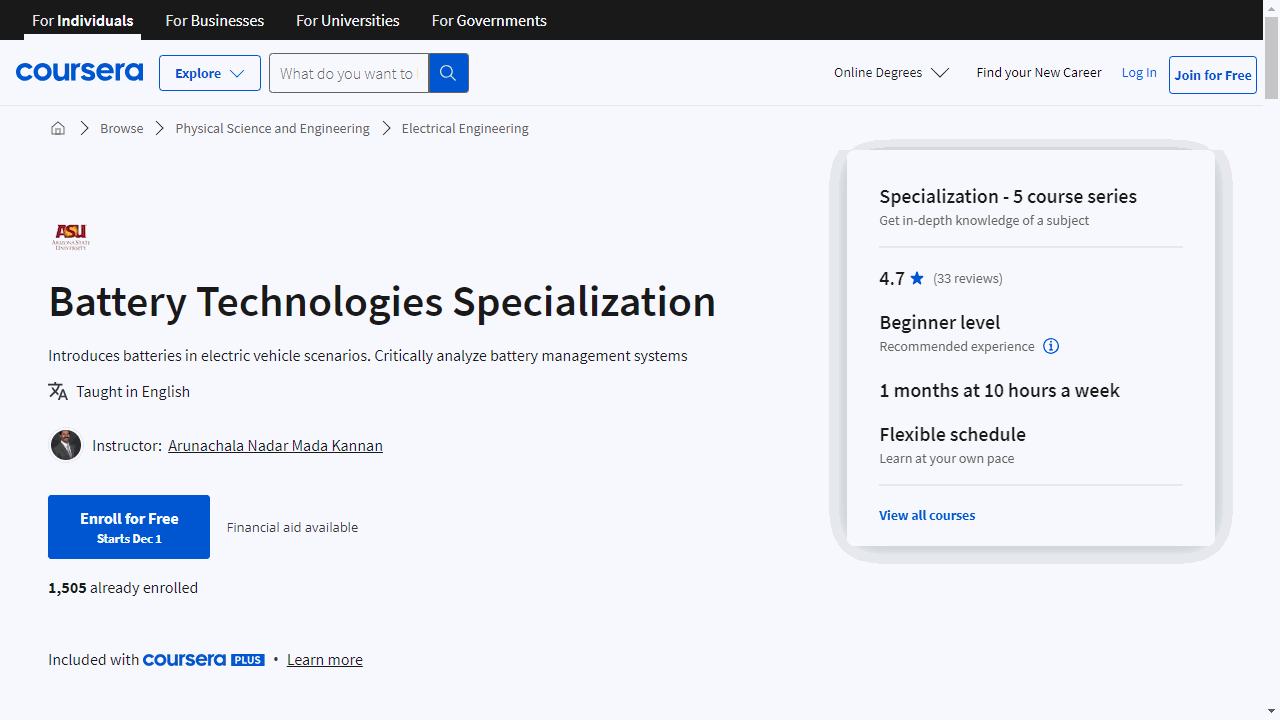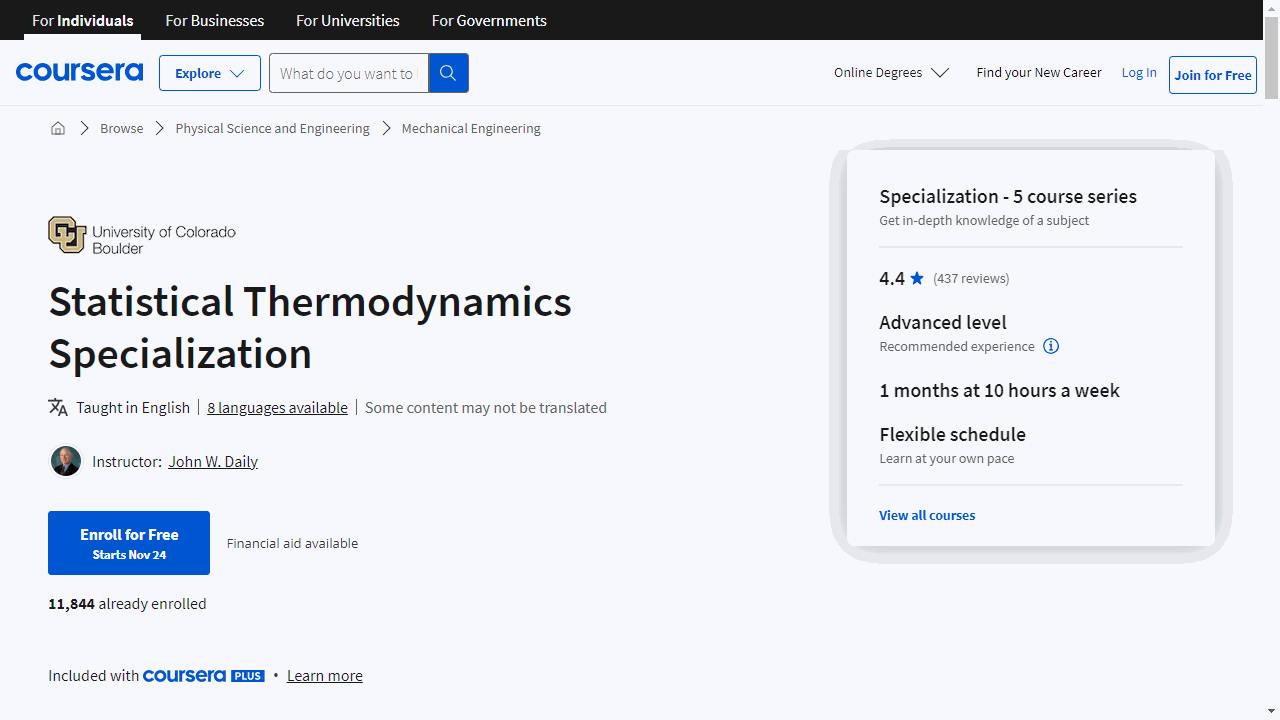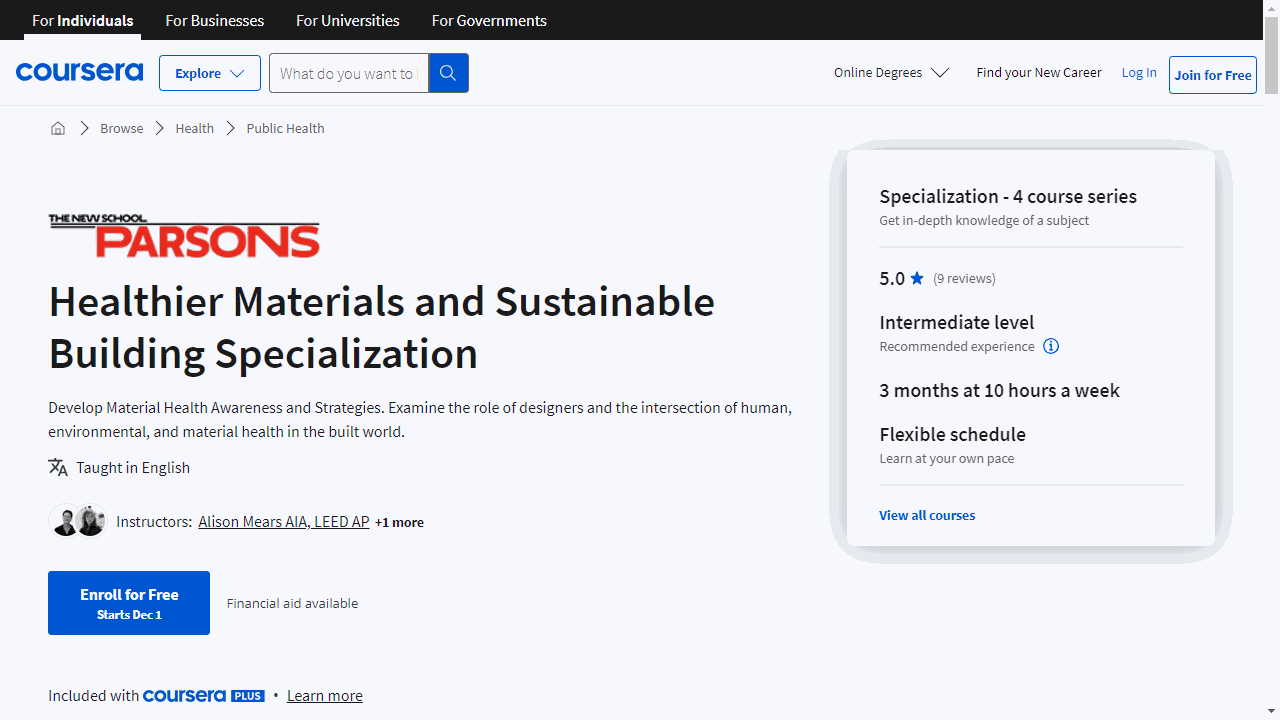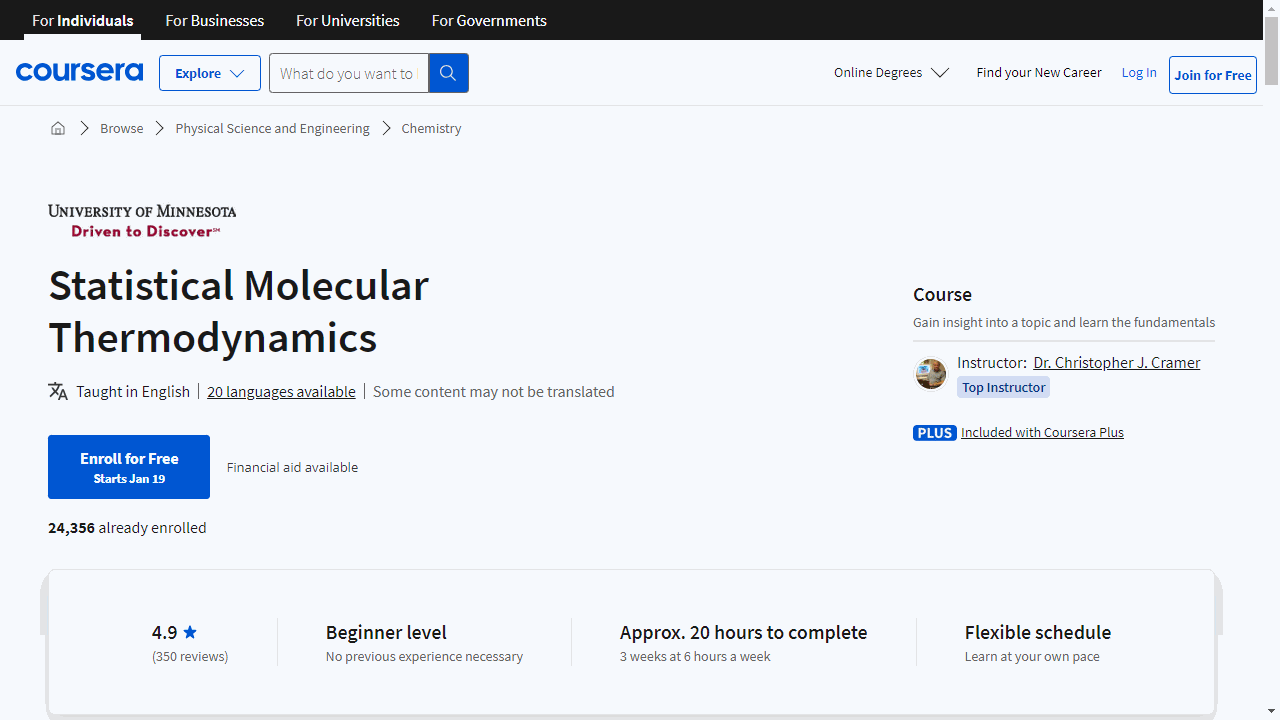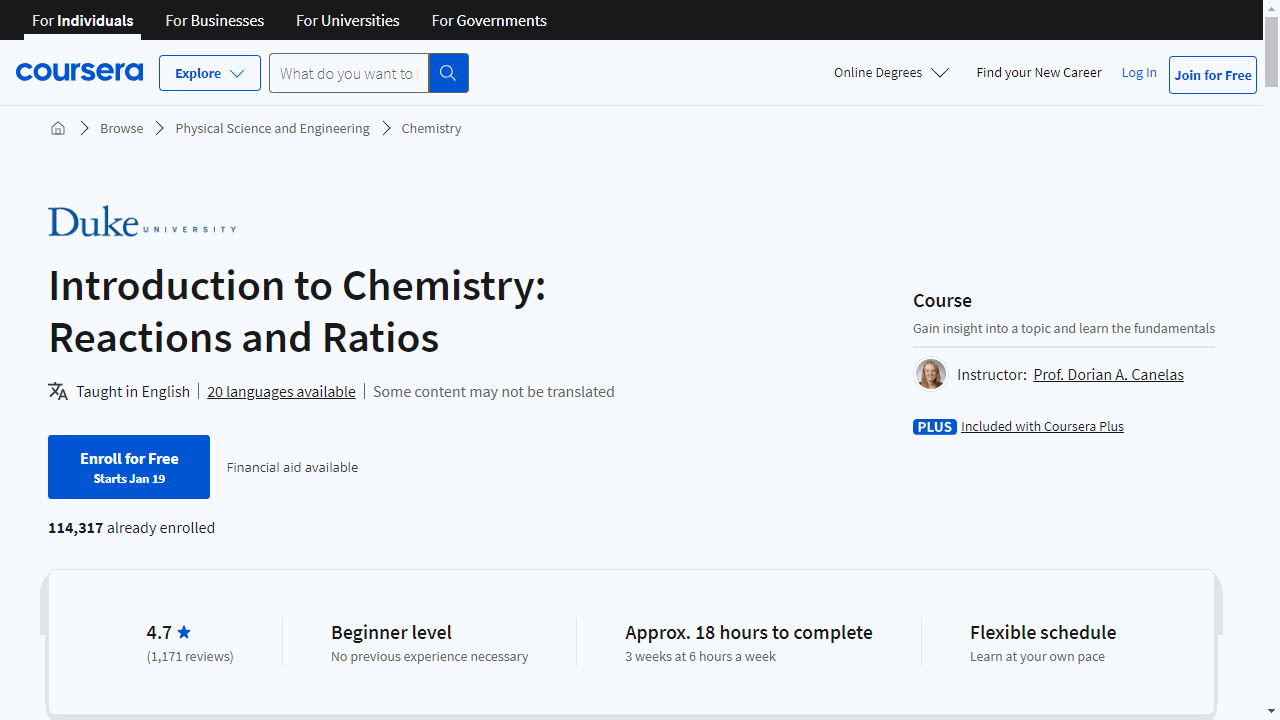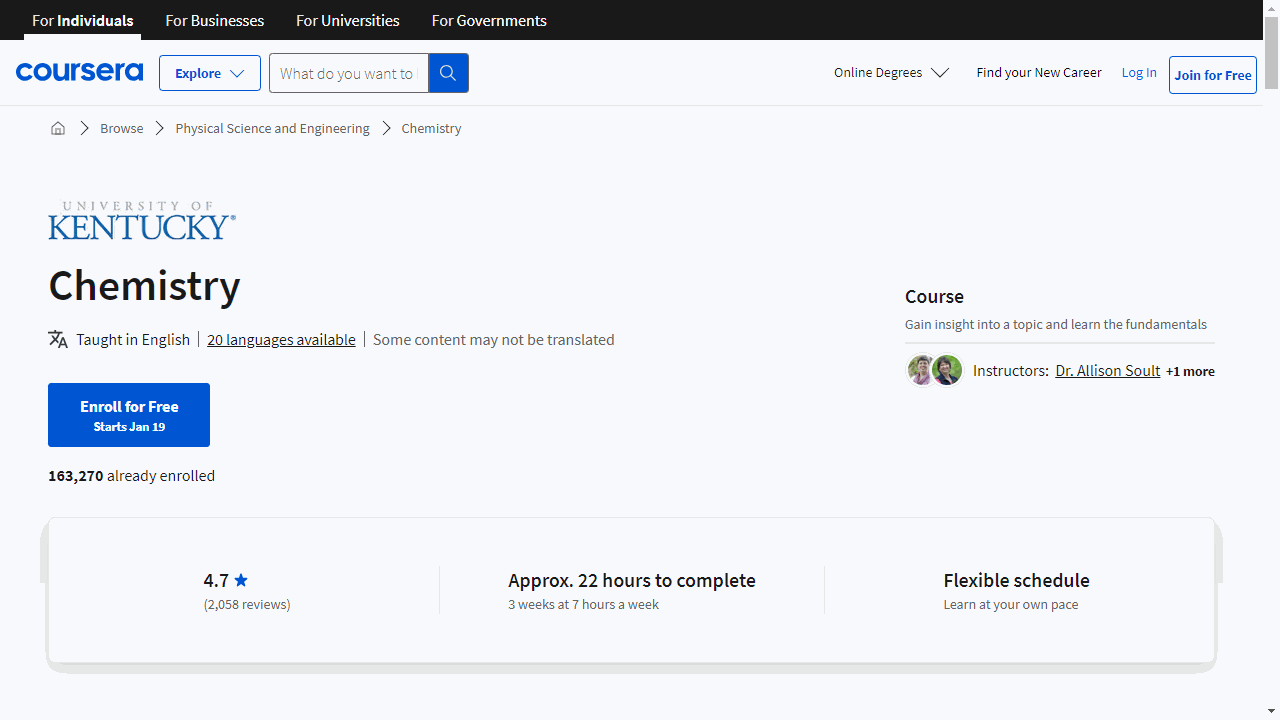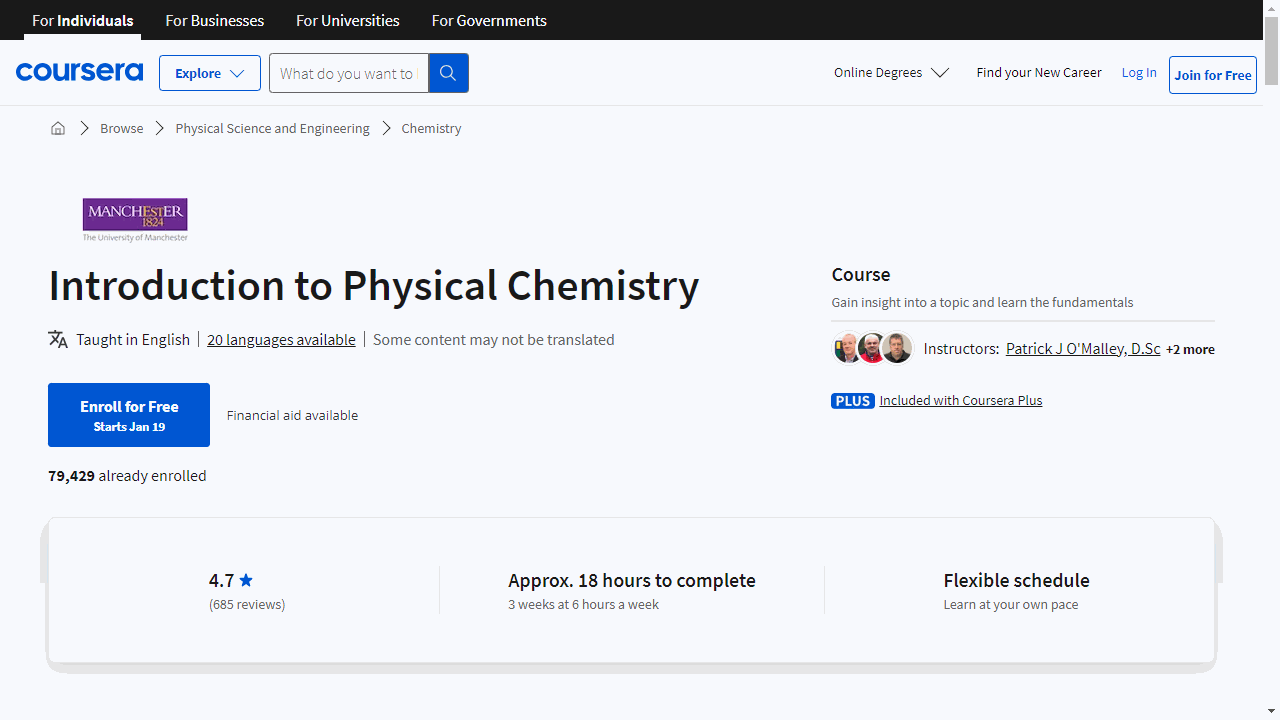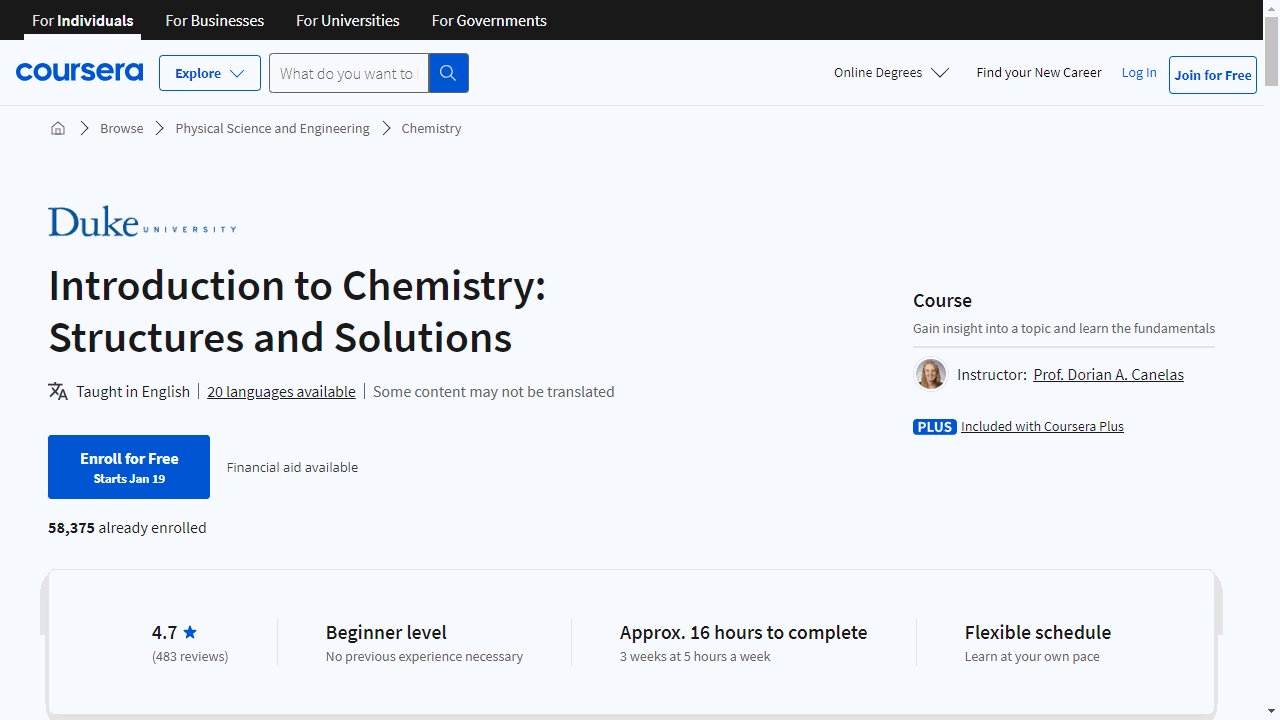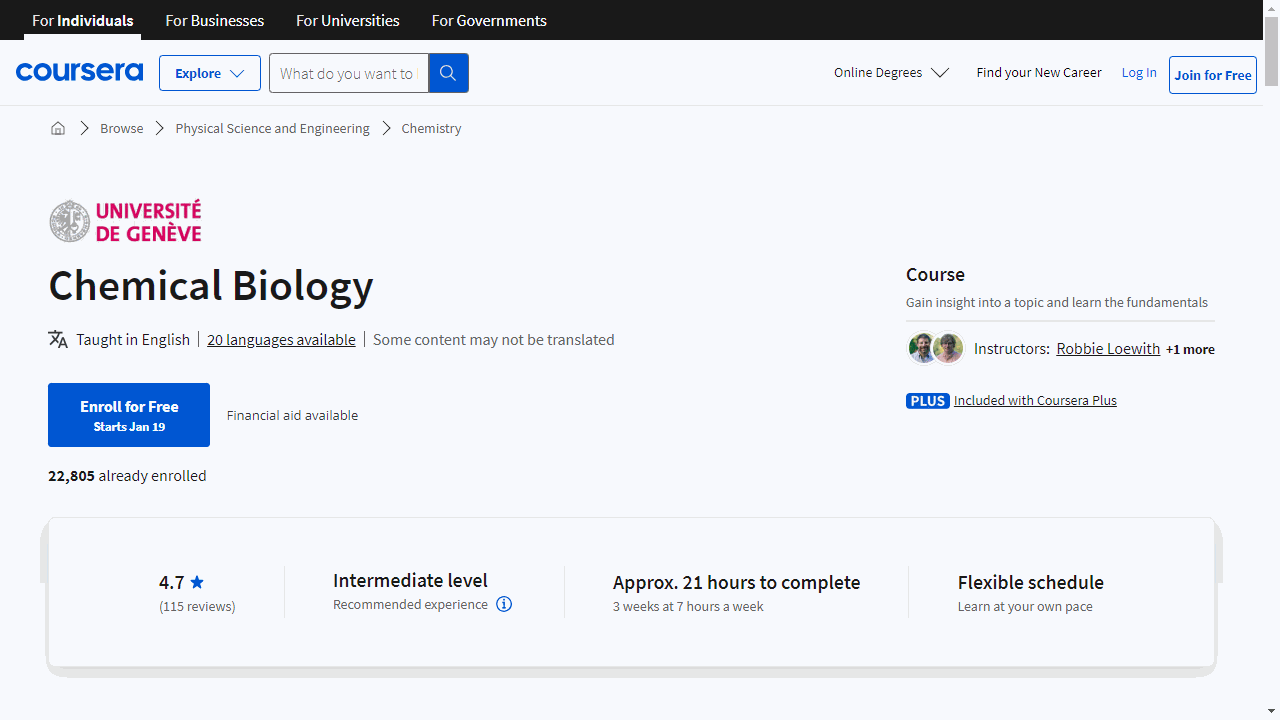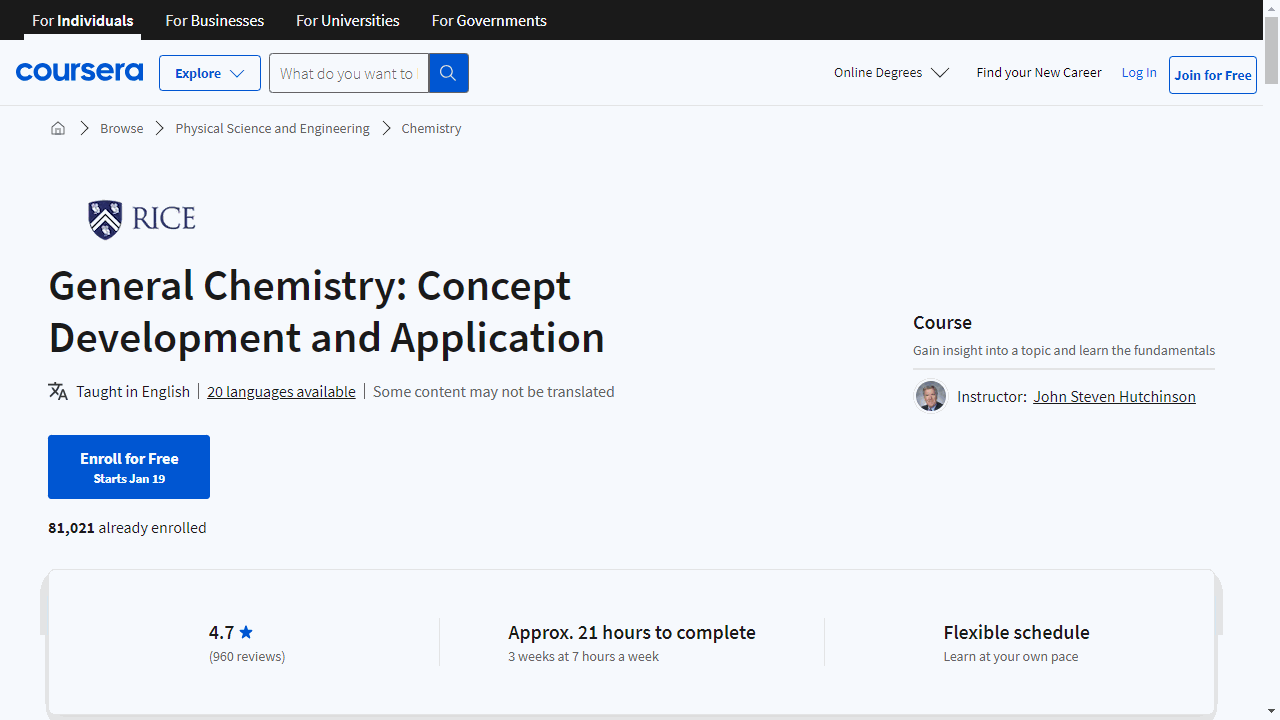Learning chemistry can be a daunting task, especially if you’re trying to navigate the vast landscape of online courses.
There are so many options available, each with its own focus, teaching style, and level of difficulty.
It can be overwhelming to find the right course that aligns with your goals and learning preferences.
That’s why we’ve compiled this list of the best chemistry courses on Coursera, meticulously curated to cater to different learning styles and areas of interest.
For the best chemistry course overall, we recommend Statistical Molecular Thermodynamics by the University of Minnesota.
This course delves deep into the energy of molecules, providing a profound understanding of the microscopic forces that drive the macroscopic world.
It covers fundamental concepts like quantization of energy, the behavior of ideal and real gases, Boltzmann’s theories, and the laws of thermodynamics.
With its clear explanations, regular reviews, and abundant resources, this course equips you with the knowledge and confidence to excel in your chemistry journey.
But our recommendations don’t end there.
We’ve included a variety of other outstanding courses focusing on specific topics, from electrodynamics and battery technologies to sustainable building and chemical biology.
So, whether you’re a beginner looking for a foundational understanding or an advanced learner seeking in-depth knowledge, there’s a course on this list that’s perfect for you.
Keep reading to explore our comprehensive guide to the best chemistry courses on Coursera!
Electrodynamics Specialization
Offered by the Korea Advanced Institute of Science and Technology (KAIST).
The specialization starts with the “Electrodynamics: An Introduction” course is your first step into the realm of electromagnetism, laying a solid foundation with vector calculus and electrostatics.
This isn’t just theory; it’s about connecting the dots to real-world applications like energy storage.
Progressing to “Electrodynamics: Analysis of Electric Fields,” you’ll sharpen your skills in calculating electric fields and delve into polarization and dipoles.
As you advance to “Electrodynamics: Electric and Magnetic Fields,” magnetostatics comes into play, linking to prior knowledge and introducing electromotive force.
The final leap in this series, “Electrodynamics: In-depth Solutions for Maxwell’s Equations,” challenges you to tackle complex systems and AC circuits.
This course goes beyond the basics, offering a comprehensive understanding of Maxwell’s Equations in dynamic scenarios.
Each course is meticulously crafted to ensure a seamless transition from theory to application, enriched with Feynman’s insightful approach to physics.
Battery Technologies Specialization
If you’re particularly interested in electric vehicles and smart energy systems, this specialization is for you.
Dive into “Primary and Secondary Batteries” to grasp the essentials of battery operation.
You’ll learn to enhance energy and power density for automotive applications, making you a key player in advancing battery technology.
For a specialized focus, “Zn and Ni Based Batteries” offers a deep dive into the materials and chemistry of Zinc and Nickel batteries.
You’ll master the art of selecting and sizing batteries for various devices, equipping you with the precision of a skilled technician.
“Lithium Based Batteries” zeroes in on the most sought-after battery type in the market.
You’ll uncover the intricacies of Lithium battery materials and processes, positioning you at the forefront of this critical industry segment.
In “Battery Comparison, Manufacturing, and Packaging,” you’ll navigate the complexities of battery management systems.
Understanding electrical and thermal protections, cell balancing, and health estimation will make you indispensable in the battery manufacturing field.
Finally, “Batteries and Electric Vehicles” connects your newfound knowledge to the booming EV sector.
You’ll explore battery performance, charging infrastructure, and regulatory landscapes, preparing you to lead in the zero-emission vehicle revolution.
Statistical Thermodynamics Specialization
Starting with “Fundamentals of Macroscopic and Microscopic Thermodynamics,” you’ll delve into the core principles like temperature and pressure.
This course demystifies the link between the microscopic world of molecules and the macroscopic properties we observe, setting a solid foundation for your journey.
Moving on to “Quantum Mechanics,” the specialization takes a leap into the quantum realm.
You’ll tackle the Schrödinger wave equation and gain insights into atomic behavior.
The course simplifies complex quantum chemistry, providing you with practical skills to solve quantum problems.
“Ideal Gases” shifts the focus to systems where intermolecular forces take a backseat.
You’ll explore various gas behaviors and their industrial relevance, learning to predict how gases will respond under different conditions using partition functions.
In “Dense Gases, Liquids and Solids,” the course examines what happens as gases condense.
You’ll understand the transition from gas to liquid and solid states, and learn to use the radial distribution function to analyze liquid properties.
Lastly, “Non-Equilibrium Applications of Statistical Thermodynamics” applies your knowledge to dynamic systems.
From gas transport properties to the intricacies of chemical kinetics, this course covers essential topics like spectroscopy and computational tools for kinetic calculations.
Healthier Materials and Sustainable Building Specialization
In “Building Materials and Human Health,” you’ll uncover the hidden impacts of building materials on our well-being.
This course equips you with the skills to assess and mitigate toxic exposure, making you a savvy selector of healthier materials.
It’s ideal if you have a background in design or architecture, but even without it, you’ll gain valuable insights.
“Material Chemistry and Sustainable Building” takes you deeper into the science of sustainable materials.
You’ll learn to identify and replace harmful chemicals in the built environment.
This knowledge is crucial for anyone looking to lead in the field of green building.
For those with leadership experience in design or architecture, “Sustainable Building: Design and Specification” offers a transformative perspective on material selection.
You’ll learn to prioritize health in your design choices, using cutting-edge tools and resources.
Lastly, “Sustainable Construction in a Circular Economy” broadens your understanding of sustainability in the construction process.
You’ll explore circular design principles and their role in reducing carbon footprints, fostering a regenerative and equitable world.
Each course is rich with practical skills like Green Design and Project Communication, preparing you to make informed decisions that benefit both human health and the environment.
Statistical Molecular Thermodynamics
Provider: University of Minnesota
This course is a deep dive into the energy of molecules and how they shape the world around us.
It leaves you with a profound understanding of the microscopic forces that drive the macroscopic world, preparing you for a future in chemistry with confidence and clarity.
You’ll kick things off with a bang, exploring the thermite reaction to understand energy release at a molecular level.
This sets the stage for learning about quantization of energy, which is the concept that energy comes in small, discrete packets.
As you progress, you’ll get up close with atoms and molecules, discovering how they move and store energy.
From the simplicity of a hydrogen atom to the complexity of polyatomic molecules, you’ll learn the energetic dance that constructs everything we see and touch.
The course then guides you through the behavior of gases, both ideal and real-world scenarios, using equations like the Ideal Gas Law and the van der Waals equation.
It’s like having a toolkit to predict how gases will respond under various conditions.
Boltzmann’s theories are next on the agenda, offering insights into the likelihood of molecular events.
This knowledge is key to understanding the natural world at the microscopic level.
You’ll also tackle the fundamental laws of thermodynamics, which govern energy, work, and heat.
These principles are the universal rules that dictate every energetic interaction in the cosmos.
Entropy, a central theme in thermodynamics, will become clear to you.
You’ll grasp its significance in determining the direction of chemical reactions and the dispersal of energy, akin to understanding the natural tendency for disorder.
In the final stretch, you’ll delve into free energy concepts, learning from Helmholtz and Gibbs how to predict the spontaneity of chemical reactions.
This is crucial for anyone interested in the practical applications of chemistry.
Throughout the course, regular reviews and a wealth of resources ensure you’re supported every step of the way.
Plus, the course instructor is there to help illuminate the path through these complex topics.
Introduction to Chemistry: Reactions and Ratios
Provider: Duke University
This course demystifies the essentials of chemistry, making it accessible and engaging for you.
You’ll start with the scientific method, learning to question, observe, and experiment like a pro.
The course ensures you understand measurements and significant figures, which are crucial for accurate scientific work.
Dive into the nature of matter and the role of energy in chemical processes, with each concept broken down into manageable parts.
Stoichiometry won’t be intimidating anymore, as you’ll tackle chemical formulas and the concept of the mole, complete with demonstrations to see theory in action.
Math in chemistry is made approachable with quizzes and tips, ensuring you’re comfortable with the calculations involved.
The course also guides you through the periodic table, ions, isotopes, and the types of chemical bonds, including ionic and covalent.
Thermochemistry introduces you to heat transfer in substances, complemented by a practical demo on density.
You’ll learn to determine oxidation states, name compounds correctly, and calculate formulas, which are essential skills for understanding chemical composition.
Balancing chemical equations and performing reaction calculations are covered in detail, giving you the confidence to predict the outcomes of chemical reactions.
The course also delves into solutions, solubility, and the principles governing dissolution.
Acid-base and redox reactions are explained in a straightforward manner, highlighting their importance in everyday chemistry and broader scientific applications.
By the end of this course, you’ll have a solid foundation in chemistry, equipped with the knowledge to understand and engage with chemical reactions and ratios.
Chemistry
Provider: University of Kentucky
This course gives you a thorough understanding of chemistry, from the ground up.
In Unit 1, you’ll start with the basics, exploring subatomic particles and the nucleus.
You’ll unravel the mysteries of light and quantum theory, including the photoelectric effect and the energy of photons.
Concepts like Bohr’s model and the Heisenberg Uncertainty principle will become clear as you delve into atomic theory and electron behavior.
Unit 2 will turn you into a Periodic Table expert.
You’ll learn how atomic and ionic radii are determined, the significance of ionization energy, and the properties of representative elements.
Understanding electron configurations will be a breeze, helping you predict how atoms will interact.
Unit 3 focuses on chemical bonds and formulas.
You’ll master the art of naming compounds with IUPAC standards and calculating molar masses.
This unit is crucial for grasping the composition of compounds and the relationships between their formulas.
In Unit 4, the course shifts to chemical reactions.
You’ll learn to balance equations and study key reaction types, including precipitation, acid-base, and oxidation-reduction reactions.
These concepts are vital for understanding the chemical processes that occur around us every day.
Stoichiometry takes center stage in Unit 5, where you’ll learn to quantify the outcomes of chemical reactions.
You’ll also tackle solution concentration, learning to calculate molarity and perform dilutions—essential skills for any chemistry lab work.
Unit 6 introduces you to molecular structures.
Drawing Lewis structures and predicting molecular shapes using VSEPR theory will help you visualize how molecules are put together and how they interact.
Lastly, Unit 7 covers thermochemistry.
You’ll explore the energy changes in chemical reactions, delve into calorimetry, and apply the laws of thermodynamics.
This knowledge is key to understanding how energy is transferred and conserved in chemical processes.
With detailed lecture notes and practice problems, this course ensures you have the tools to succeed.
Key concepts like PF5, atomic theory, and calorimetry are woven throughout the curriculum, enriching your learning experience.
Advanced Chemistry
Provider: University of Kentucky
This course is a deep dive into the fascinating world of chemical reactions, equilibrium, acids, bases, and thermodynamics, designed to give you a comprehensive understanding of chemistry’s core concepts.
Starting with kinetics, you’ll learn how to determine the rate of chemical reactions.
This includes mastering rate laws and understanding the significance of first-order and second-order kinetics.
You’ll also explore the principles behind the Collision Theory and the Arrhenius Equation, which explain how factors like temperature influence reaction rates.
When it comes to chemical equilibrium, you’ll get hands-on with the Law of Mass Action and Le Chatelier’s Principle.
These concepts will help you predict the effects of changing conditions on a reaction, a crucial skill in practical chemistry.
Acid-base chemistry is another key focus.
You’ll delve into the intricacies of pH, acid strength, and the behavior of ions in water.
This knowledge is vital for applications ranging from digestion to pharmaceuticals.
Buffer solutions are your next stop.
You’ll learn how to create and use these vital tools to maintain stable pH levels in various settings.
Plus, you’ll gain expertise in titration techniques, essential for quantifying acid or base concentrations in a solution.
Thermodynamics will round out your learning experience.
You’ll explore the energy changes that occur during reactions, understanding concepts like enthalpy, entropy, and Gibbs Free Energy.
This will equip you to predict whether a reaction is spontaneous or requires external energy.
Throughout the course, you’ll tackle practice problems to solidify your understanding and prepare you for real-world applications.
Introduction to Physical Chemistry
Provider: University of Manchester
This course is a comprehensive journey through the essential principles of physical chemistry, tailored to give you a strong understanding of how matter and energy interact.
You’ll start with thermodynamics, where you’ll grasp the significance of temperature through the Zeroth Law and uncover the relationship between energy and heat with the First Law and the concept of enthalpy.
These foundational ideas set the stage for your understanding of energy transfer and chemical reactions.
The course includes practical experiments, such as using a calorimeter to measure heat changes.
Even if you’re not on campus, the virtual lab experience allows you to conduct these experiments remotely, ensuring you don’t miss out on the hands-on learning that brings these concepts to life.
When you delve into chemical kinetics, you’ll learn to predict the rates of chemical reactions.
By studying zero, first, and second order reactions, you’ll understand how different factors influence the speed of reactions, a crucial skill in any chemistry-related field.
Quantum chemistry is another highlight, with Dr. Patrick O’Malley guiding you through the quantum realm.
You’ll explore Planck’s Quantum of Energy, the particle nature of light, and Heisenberg’s Uncertainty Principle.
The course also includes simulations like the spectrometer, allowing you to apply quantum concepts in a virtual environment.
Throughout the course, you’ll receive personalized feedback on experiments, from gas measurements with a burette to hydrogen emission observations.
This feedback refines your understanding and skills in real-time.
Introduction to Chemistry: Structures and Solutions
Provider: Duke University
This course lays a strong foundation in chemistry with a focus on practical understanding and real-world applications.
You’ll start with the basics of the scientific method, learning to take precise measurements and understand the importance of significant figures.
This attention to detail is crucial in chemistry, where accuracy is key.
Energy, a central concept in chemistry, is covered in depth.
Through engaging demonstrations, you’ll see firsthand the difference between physical and chemical changes.
These demos not only make learning fun but also help you grasp complex concepts more easily.
The course shines a light on atomic theory, introducing you to the Bohr Model and the fascinating world of light waves and atom emission spectra.
You’ll witness the beauty of colored flames and gain a clear understanding of quantum numbers and electron configurations.
Drawing Lewis structures will become second nature to you, as you learn to depict molecules and predict their behavior.
You’ll also delve into molecular geometry with the Valence Shell Electron Pair Repulsion theory and explore the different types of chemical bonds, including sigma and pi bonds, and the concept of hybridization.
When it comes to states of matter, you’ll get hands-on experience with demonstrations that show how gases respond to pressure and the role of thermal energy.
The course also demystifies the phases of matter, from liquids to solids, and the transitions between them.
Solutions are a big part of chemistry, and you’ll learn all about them, from the factors affecting solubility to the calculations needed for making precise dilutions.
The course even includes a segment on the solubility product constant, helping you understand how to predict when a substance will dissolve.
Throughout the course, expert interviews, like the one with Dr. Dubay, offer additional insights, enriching your learning experience.
By the end of this course, you’ll have a solid grasp of chemistry fundamentals, equipped with the knowledge to tackle more advanced topics.
If you’re eager to learn chemistry through a hands-on, engaging approach, this course is exactly what you’ve been searching for.
Chemical Biology
Provider: University of Geneva
This course is a deep dive into the molecular mechanics of life, blending chemistry and biology in a way that’s both accessible and engaging.
You’ll start with the fundamentals, exploring the monomeric units of proteins and DNA—essentially the building blocks of your body.
Understanding these elements is crucial for grasping how biological messages are sent and received at a cellular level.
As you progress, the course offers a real-time look at cellular processes.
You’ll become familiar with proteins and enzymes, the diligent workers of the body’s cellular machinery, and learn how to track and measure their activities using various analytical methods.
Fluorescence principles and applications come next, illuminating the inner workings of cells.
This module is like gaining a superpower to see biological processes in a new light, literally.
You’ll then get hands-on with transformative techniques such as RNA interference and genome editing—tools that have revolutionized our ability to modify DNA and have vast implications for treating diseases.
The course also delves into the architecture of DNA within cells and its connection to conditions like cancer.
Techniques like TIRF microscopy will become part of your toolkit, allowing you to observe molecules interacting with DNA up close.
Later modules have you tracking proteins in live cells, designing experiments, and understanding cellular stress responses.
You’ll also investigate lipids, the fats that are vital to cellular function, and their role in signaling and disease mechanisms.
Wrapping up, you’ll explore peptide nucleic acids and their use in creating vast libraries of molecules for drug discovery and understanding disease pathways.
You’ll learn about the power of diversity in molecular libraries and the strategies used to screen for therapeutic candidates.
By the end of this course, you’ll not just have knowledge; you’ll have the experience of applying it through experimental design and critical analysis.
General Chemistry: Concept Development and Application
Provider: Rice University
This course gives you a comprehensive understanding of chemistry, from the ground up.
You’ll start with the basics of Atomic Molecular Theory, where you’ll learn about the fundamental components of matter.
This foundation is crucial for grasping more complex concepts later on.
Then, you’ll move on to Atomic Masses and Molecular Formulas.
Over five focused sessions, you’ll master how to calculate the weight of atoms and understand the recipes for different molecules.
The journey continues with Atomic Structure and the Electron Shell Model of an Atom.
In these sessions, you’ll discover the inner workings of atoms and the layers that dictate their chemical behavior.
Quantum Energy Levels in Atoms will introduce you to the energetic aspects of atoms, while sessions on Electron Orbitals and Electron Configurations will reveal where electrons live and how they determine chemical reactivity.
Covalent Bonding and Electron Pair Sharing will be demystified over three sessions, showing you how atoms form strong connections by sharing electrons.
You’ll also delve into Molecular Structures and Molecular Geometry, learning how the shape of molecules influences their function and interactions.
The course covers the Energy and Polarity of Covalent Bonds, Metals and Salts, and how to measure energy changes in chemical reactions, giving you insight into the forces that drive chemical processes.
You’ll explore the behavior of gases, the principles of Kinetic Molecular Theory, and the dynamics of Phase Transitions and Equilibrium, which explain how substances change state and maintain balance.
Further, you’ll study Phase Equilibrium in Solutions, Reaction Rate Laws, Reaction Kinetics, and Reaction Equilibrium, equipping you with the tools to predict and understand the pace and balance of chemical reactions.
The course concludes with a deep dive into Acid Ionization Equilibrium, Entropy and the Second Law, and Free Energy and Equilibrium, where you’ll learn about the principles that govern reaction direction and energy flow in chemical systems.
Rice University’s course is structured to make complex ideas accessible and engaging.
With a clear progression from basic to advanced topics, you’ll gain both theoretical knowledge and practical insights.
